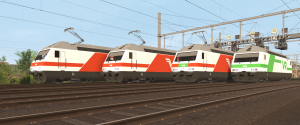
From left to right: “V-shaped logo” livery (units 3201-3221), standard red livery (units 3222-3246), red livery with green fronts and the current green livery (all units from 2010 onwards).
DOWNLOAD
All the necessary dependencies are either included in the package or are avaible on the DLS. Dependencies that are not mine are property of their respective authors.
The Class Sr2 electric locomotives were introduced in 1996 for high-speed Intercity services thruought Finland, and were intended as the successors of the Soviet-built Sr1 class, wich had been built, as Finland’s first electric locomotive, by NEVZ (the Novocherkassk electric locomotive works) with Vamlet-Stromberg electrical equipment between 1973 and 1985 (plus two more units delivered in 1993 and 1996) in a total of 109 units.
VR, the Finnish Railways, placed an order to SLM and ABB for the first 20 Sr2 class locomotives in 1992, wich were to be a russian-gauge derivative of SBB CFF FFS’ already very successful Re 460 class. Soon after the order was increased by another 20 units with an option for 12 more, option wich was also taken but halved: in total, the final order was for a total of 46 Sr2 locomotives.
Part of the purchase agreement was that the Sr2 were to be built as separate components in Switzerland by SLM (wich was soon acquired by AdTranz) and ABB and then shipped to Finland for final assembly by Transtech Oy.
Compared to the swiss Re 460s, the Sr2s fetaured updated electronics and were more powerful (effectively making them closer to the BLS Re 465s instead), were fitted for the russian broad-gauge (1524mm) and the 25Kv 50Hz AC catenary electrification in use in Finland. Additionally, the Sr2s were fitted with “Unilink” couplers, wich are a derivative of the Soviet-designed SA-3 automatic coupler compatible both with other SA-3s automatic copulers and also with the older “traditional” chain-and-link coupling still in use on a sizeable part of VR’s rolling stock.
All 46 Sr2 were delivered to VR between 1995 and 2003, numbered in the 32XX range (3201 to 3246). All Sr2s were delivered in VR’s then-standard red and white livery; units 3201 to 3221 had a large V-shaped logo on their sides, wich was intended to symbolize VR’s high-speed intercity services, while units from 3222 to 3246 were fitted with a large decal of the VR logo instead.
The Sr2s were designed with a maximium speed of 230Km/h (even attaining 232Km/h during test runs), however, due to various reasons VR soon decided to limit them to 210Km/h. Depsite being intended as “universal” locomotive, in practice Sr2s have been assigned nearly-exclusively to passenger trains, with freight services taken over by the relatively slower (140Km/h) Sr1 class. During their first years of service, Sr2s were commonly seen hauling trains formed of the ubiquitous “blue coaches” of VR, wich had a maximium speed of 160Km/h; however, from the late 1990s onwards, with the introduction of the IC2-type double-decker cars, capable of a 200Km/h maximium speed, Sr2 locomotives were nearly all reassigned to haul the latters, often in push-pull formation after 2013 thanks to the introduction of the Edo-type cab cars.
From 2010 onwards, starting with unit 3221, all the Sr2 electric locomotives (along the rest of VR’s rolling stock) started to be repainted into VR’s new green livery.
Currently, all 46 Sr2s are still in service, all fitted in the new green livery, and can be commonly seen push-pulling IC2-type double-decker cars thruought the entire electrificated portion of the finnish railway network.
Trivia:
As is tradition with finnish rolling stock, the Sr2 class has recieved several nicknames, including “Marsu” (“Guinea Pig”) and “Möhkö” (“Blob”) due to it’s looks and “Alppiruusu” (“Edelweiss”) and “Käkikello” (cuckoo clock) due to it’s swiss origins.
